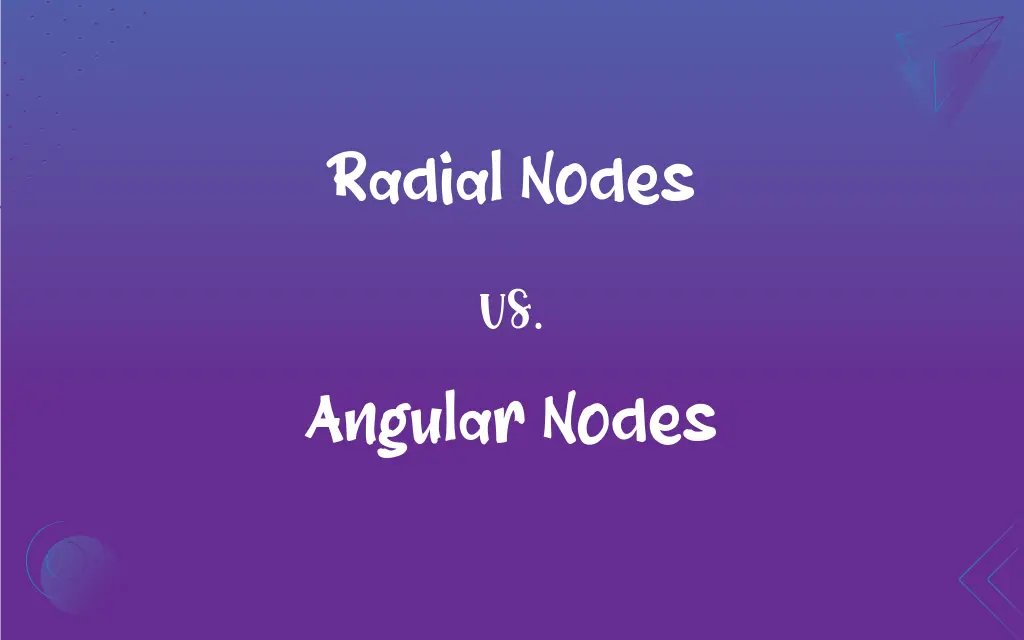Radial Nodes vs. Angular Nodes: What's the Difference?
Edited by Aimie Carlson || By Janet White || Published on March 5, 2024
Radial nodes are regions in an atom where the probability of finding an electron is zero due to distance from the nucleus; angular nodes are due to angular orientation.

Key Differences
Radial nodes and angular nodes are concepts in quantum chemistry related to the wave function of electrons in atoms. Radial nodes refer to areas within an atom where the probability of finding an electron is zero, due to the electron's distance from the nucleus. These nodes are spherical surfaces in the atom and increase in number with the principal quantum number. Angular nodes, on the other hand, are related to the angular part of the wave function and result from the electron's orientation around the nucleus. They are defined by the angular momentum quantum number and manifest as planes or cones where the probability of finding an electron is zero.
In the context of atomic orbitals, radial nodes signify the electron's transition between different energy states as it moves away from or towards the nucleus. Angular nodes, however, delineate the shape of the orbital, influencing the directional characteristics of the electron's probability density. For example, p orbitals have one angular node, which dictates their dumbbell shape, whereas s orbitals, with no angular nodes, are spherical.
The distinction between radial and angular nodes is fundamental for understanding electron configuration and the shapes of atomic orbitals. Radial nodes affect the electron's radial probability distribution, implying variations in energy levels within the same principal quantum number. Angular nodes define the orbital's geometric orientation, critical for molecular bonding and the electronic structure of molecules.
Understanding radial and angular nodes aids in predicting chemical behavior and bonding patterns. Radial nodes contribute to our understanding of the atom's size and energy levels, essential for quantum mechanics and spectroscopy. Angular nodes inform the spatial distribution of electrons, vital for deciphering molecular geometry and the principles of chemical bonding and reactivity.
Comparison Chart
Definition
Spherical surfaces where electron probability is zero
Planes or cones where electron probability is zero
ADVERTISEMENT
Determined By
Principal and azimuthal quantum numbers
Azimuthal quantum number
Influence on
Electron's radial distribution
Electron's angular orientation
Impact on Orbital Shape
Affects size and energy levels
Defines orbital shape and directionality
Radial Nodes and Angular Nodes Definitions
Radial Nodes
Reflects the electron's distance from the nucleus where probability drops to zero.
Increasing the principal quantum number increases the number of radial nodes in an orbital.
Angular Nodes
Dictates the shape and orientation of atomic orbitals.
Angular nodes give p orbitals their distinctive dumbbell shape by dividing the orbital into lobes.
ADVERTISEMENT
Radial Nodes
Influenced by both the principal and azimuthal quantum numbers.
The number of radial nodes in an orbital is calculated by subtracting one from the difference between its principal and azimuthal quantum numbers.
Angular Nodes
Determined solely by the azimuthal quantum number.
The number of angular nodes is equal to the azimuthal quantum number, defining orbital geometry.
Radial Nodes
A characteristic feature of the radial wave function of electrons.
Radial nodes in hydrogen-like atoms help visualize the electron's spatial distribution.
Angular Nodes
Planar or conical regions around an atom where no electron can be found.
The d orbitals have two angular nodes, forming complex shapes compared to s and p orbitals.
Radial Nodes
Spherical regions within an atom with zero electron probability.
The 3s orbital has two radial nodes indicating regions where electrons are not found.
Angular Nodes
Influences the directional characteristics of electron distribution.
Angular nodes are responsible for the directional nature of chemical bonding in molecules.
Radial Nodes
Determines the electron's energy level transitions within the atom.
Radial nodes are critical for understanding the electron's radial probability distribution.
Angular Nodes
Represents angular positions around the nucleus with zero electron probability.
Angular nodes in an orbital illustrate the areas where electrons are least likely to be found.
FAQs
How are radial nodes determined?
They are determined by the principal and azimuthal quantum numbers of the electron.
What signifies a radial node in an orbital?
A radial node signifies a region of zero electron probability due to the electron's distance from the nucleus.
How does the number of radial nodes relate to the electron's energy?
The number of radial nodes relates to the electron's radial distribution and energy levels within the atom.
Can the number of radial nodes change in an orbital?
Yes, the number of radial nodes changes with the principal and azimuthal quantum numbers.
What are angular nodes?
Angular nodes are planes or cones around the nucleus where the electron probability is zero due to its angular orientation.
What role do angular nodes play in molecular bonding?
Angular nodes influence the directional nature of orbitals, crucial for predicting the geometry of molecules and their bonds.
Can an orbital have both radial and angular nodes?
Yes, orbitals can have both types of nodes, with the exact numbers determined by their quantum numbers.
How does the presence of radial nodes influence chemical properties?
Radial nodes influence the atom's size and the energy levels of electrons, affecting reactivity and bonding.
What happens to radial nodes as the principal quantum number increases?
As the principal quantum number increases, the number of radial nodes increases, indicating more regions of zero electron probability.
What are radial nodes?
Radial nodes are spherical areas within an atom where the probability of finding an electron is zero.
Why are radial nodes important in quantum chemistry?
Radial nodes are important for understanding the electron's spatial distribution and energy transitions.
Are angular nodes present in all types of orbitals?
Angular nodes are present in p, d, and f orbitals but not in s orbitals due to their spherical shape.
What is the significance of knowing the number of nodes in an orbital?
Knowing the number of nodes helps predict the electron configuration, chemical behavior, and bonding patterns of atoms.
How do angular nodes affect an orbital's shape?
Angular nodes dictate the shape and orientation of the orbital, influencing its directional properties.
How do radial and angular nodes contribute to the understanding of atomic structure?
They help visualize and understand the electron distribution within an atom, essential for the study of atomic and molecular physics.
How do radial nodes differ from angular nodes in visualization?
Radial nodes are visualized as spherical shells, whereas angular nodes are seen as planes or cones dividing the orbital space.
Can the number of angular nodes affect an orbital's energy?
Indirectly, as angular nodes define the orbital shape and symmetry, influencing the electron's energy distribution.
About Author
Written by
Janet WhiteJanet White has been an esteemed writer and blogger for Difference Wiki. Holding a Master's degree in Science and Medical Journalism from the prestigious Boston University, she has consistently demonstrated her expertise and passion for her field. When she's not immersed in her work, Janet relishes her time exercising, delving into a good book, and cherishing moments with friends and family.
Edited by
Aimie CarlsonAimie Carlson, holding a master's degree in English literature, is a fervent English language enthusiast. She lends her writing talents to Difference Wiki, a prominent website that specializes in comparisons, offering readers insightful analyses that both captivate and inform.































































